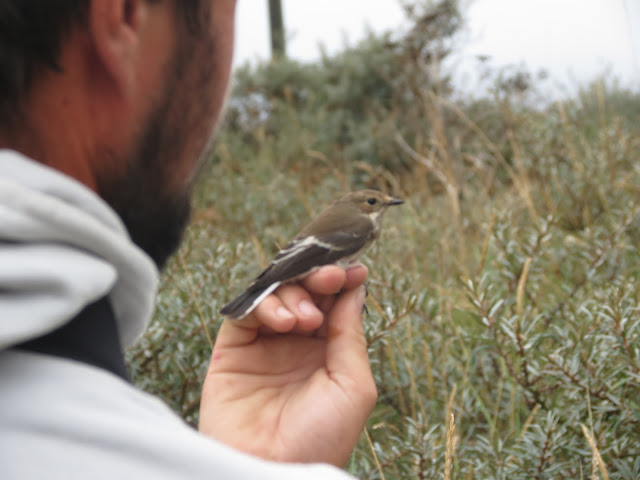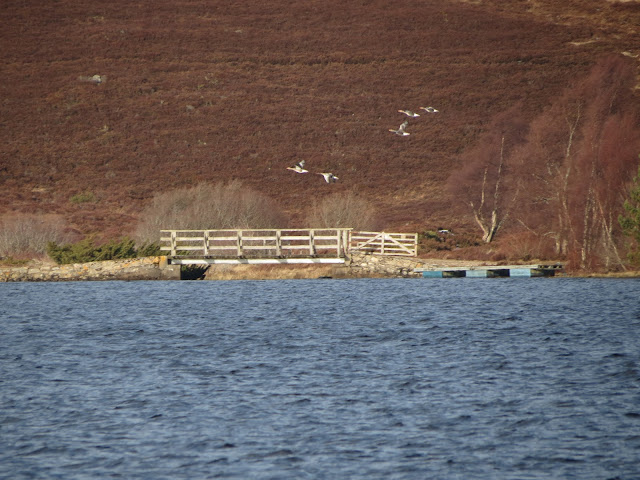Spurn Migfest!
Spurn Migfest!
We arrived in North Field at Spurn at around 8:00am, after dipping the Pallid Harrier at Long Bank Marsh by 10 minutes. We were accompanied by Keith and Dave who had given us a lift. We had been told by Wayne Glossop that a Red-backed Shrike was showing near the marquees, so we made our way there and were greeted by a huge crowd of birders. We walked towards them and after listening to a few of the other birders describe where the bird was, I managed to spot the Red-backed Shrike distantly perched on top of a hedge. It then came closer in, but only for a few seconds, before it flew out of view.
Since we were in North Field, we decided to check out some of the stands in the marquees. We also met a few familiar faces. Then, news broke out of a Wryneck in Schipper's Field about 45mins ago. Suddenly, everyone was in a rush to get to the field, but as soon as we got there, we were told there had been no sign of it. Not discouraged, we decided to look around the hedges bordering the field when Dave spotted a very showy Spotted Flycatcher. This year had probably been and will most likely always be my best year for Spotted Flycatchers. I had seen c50 during my week on Bardsey Island, I found a nest a week later and I have since stumbled upon many more Spotted Flycatchers on their breeding grounds and (since last week) on migration.
We then got word that the Wryneck was on show just outside of Syke's Field. In a matter of a minutes, there were a huge crowd of birders all in one narrow space. Luckily, I managed to squeeze my way through the crowd and after getting some directions from a few birders, I finally managed to get onto the Wryneck, which was incredibly distant. I then proceeded to get some horrible record shots of the bird. While everyone was enjoying the Wryneck, few had noticed the two very showy Spotted Flycatchers and the very showy Lesser Whitethroat, both right in front of us. Unfortunately, I couldn't get a picture of either birds, since they were obstructed by a metal gate for me.
I then looked through someone's scope, which gave much clearer views of the Wryneck before it landed further down on the barbed wire behind some very annoying branches. This was only my second Wryneck, my first one also being at Spurn two years ago.
Satisfied with our day so far, we decided to make our way over to the Warren to see some ringing and do a bit of seawatching. On the way to the Warren, we spotted lots of Barn Swallows getting ready for their migration south, along with, sadly, a dead Pied Flycatcher. Once we were at the Warren Gate, we met a large crowd of birders. One of the birders told me they were scanning through a large Bar-tailed Godwit flock. Seeing as this had been a bit of a bogey bird for my year list so far, Dave set his scope and tripod up for me to try and find the godwits. After a few seconds, I managed to lock onto a bird with a long, upturned bill and a streaky back. It was a Bar-tailed Godwit, finally!
Someone then said that they had a Spotted Redshank. After following their directions, I managed to find the Spotted Redshank, which was feeding by itself separate from any waders. After getting a few digiscoped images of both the waders, we made our way over to the ringing demonstration, only to realise that they had temporarily wrapped up the nets due to the poor weather. We then proceeded to do a seawatch, which was extremely quiet, only producing a few Gannets and a Grey Seal.
News then broke out of yesterday's male Red-breasted Flycatcher still present in Kew Villa. Suddenly, we were back up on our feet, walking along Canal Bank to get to quickly get to Kew Villa but to also spot some more migrating birds. At first, we spotted a bird fly past before spotting it in a bush a few seconds later. Although it was brief, it was enough to identify it as a Redstart. We then met two birders further down the footpath who were watching a much showier Redstart. Dave quickly set up his scope and we all got great views of a bird which had also eluded me this year.
We then continued down Canal Bank, hearing a Water Rail and spotting a Wheatear hopping along the rocks. This would likely be the Wheatear's final stop in the UK, before it migrated back down south to overwinter.
Once we were at Kew Villa, there was no sign of the Red-breasted Flycatcher, however, we did spot a much more common flycatcher, and another bird I was hoping to see today. It was a Pied Flycatcher! I had seen plenty on their breeding grounds this year, but I hadn't seen any on migration, so I was glad to see this one as it put on a bit of a show for us!
We then got word that my most wanted moth was being shown at the marquees in North Field. Excited, we made our way down to North Field to view the moth. Once there, we were greeted by two Convolvulus Hawkmoths which were fast asleep in a tub. The lady who was showing us the moths then picked one up, which woke it up and made it show its beautiful pink underwing.
The lady then allowed me to handle it. The Convolvulus Hawkmoth decided to climb up from my hand onto my arm, before going back to sleep. One thing I underestimated about this moth, was just how big it was. It was easily the same size as my hand!
We then went to a woodland ride where someone said they had heard the Red-breasted Flycatcher a few minutes ago. Once we were viewing the ride, the first thing we noticed were three Spotted Flycatchers fly-catching, with all 3 in one view at one point. I then spotted a young Chiffchaff which was just perched in a tree right overhead. We then got word of an Ortolan Bunting (which is a lifer) at the Warren. In a panic, we all rushed over with a large crowd of birders. Once at the Warren, we noticed two Wheatears along with a few Redstarts, Pied Flycatchers and Spotted Flycatchers, all in the scrub around the Heligoland Trap. We also met Johnathan from Bardsey Island there, along with many other people who we had met on previous twitches. We then saw that the ringing demonstration was happening again, so we watched as they showed us how they rung a Spotted Flycatcher, before showing it and then releasing it.
We were then told that the Clifden Nonpareil was on show at the obs. Giving up on the Ortolan, we hurried back over to the obs, when we were stopped in our tracks by a Lesser Whitethroat. At first it was skulking deep in the bush, but after a bit of waiting, it began to show well, long enough for me to finally get some decent record shots of it.
We couldn't believe our luck when the Lesser Whitethroat perched right on top of the bush, showing off its often overlooked beauty, before hiding away back in the bush as it continued to fatten up, ready for its migration south.
We finally arrived at the obs at around 4:30pm where we were met with a few pots, all filled with goodies. The first pot I looked at actually didn't have a moth in it at all. There was a Great Diving Beetle inside of it. Since these aquatic beetles could fly, this one was most likely attracted to the trap's light while flying from pond to pond. This was however a new species for me, so I was glad to see it!
The next pot I looked in included one of my favourite moths, the Black Rustic. Although it was one of my favourite's, I had seen quite a few before, and it wasn't a new one for me.
The next moth I saw was a classic migrant moth, a Rush Veneer. This moth wasn't new for me either, since I had found one earlier in the day in North Field.
I then looked into another pot and saw a moth which I didn't recognise. I asked about its ID and it turned out to be a Delicate, a new moth for me!
I then saw a moth potted up which was another new one for me, the Gem! This was also a migratory moth and was actually fairly uncommon. I also saw two other new moths for me: Fleabane Pearl and White-fronted Straw, the latter being incredibly small!
However, the best moth of them all was easily the Clifden Nonpareil, which was a very rare and special moth, and was another one of my most wanted. The tub it was in was a bit dirty so you couldn't see the moth very clearly, however, it was stunning.
However, rarest moth we saw wasn't actually the Clifden Nonpareil, it was the Many-lined moth, which had only been recorded in Yorkshire 4 times and was generally a fairly scarce moth in the UK.
We then met Marc Hughes and his son, who released one of the Convolvulus Hawkmoths which were in North Field earlier onto the picnic table, allowing me to get a more natural record shot of it before it flew off.
We then arrived back at the car, only to then rush over to Syke's Field after hearing of a showy very showy Wryneck. After a bit of waiting, the Wryneck showed extremely well, as it started feeding only a couple of feet away! I could make out all the beautiful shades of brown which this bird had, along with that iconic long, brown caterpillar along its back! This was easily my best Wryneck encounter to date.
We then made our final stop at Welwick Saltmarsh YWT to try to find the roosting Pallid Harrier which was reported here a few minutes ago. On the way here, Dave and Keith spotted a Little Owl on top of a farm building. Once at the saltmarsh, we followed a trail which led up to a viewing screen. From the screen, we spotted a large, distant flock of Golden Plover in flight, as well as 3 calling Greenshanks which were flying around the lake in front of us. We soon spotted our first raptor from the screen, a distant Marsh Harrier which flew past the pumping station. Next, we spotted a Buzzard and a Kestrel, when Keith suddenly spotted a distant Short-eared Owl sat on a post, an unexpected bird, yet a great one to add to the day list. After a bit of waiting, we ended up getting bitten to death by mosquitoes, so we called it a day and headed home.
Overall, a great day with many year ticks and new moths!
.JPG)
.JPG)



.jpg)
.jpg)
.JPG)
.JPG)
.jpg)

.JPG)

.JPG)
.JPG)
.JPG)
.JPG)





.jpg)

.JPG)
.JPG)
.JPG)




Comments
Post a Comment